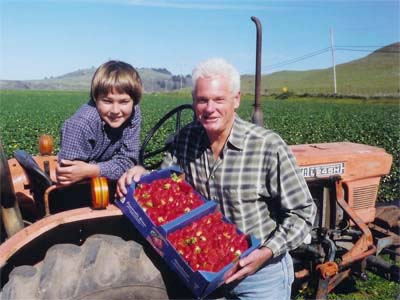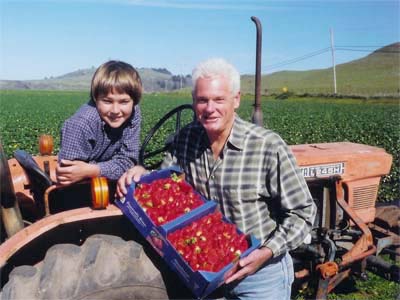 Jim Cochran on the farm in 2004.Photo: Swanton Berry FarmThis story was written by Laura Fraser.
Jim Cochran on the farm in 2004.Photo: Swanton Berry FarmThis story was written by Laura Fraser.
Along California’s rugged coastal Highway One, just north of Santa Cruz, a yellow vintage pick-up truck and tidy rows of strawberries mark the entrance to the Swanton Berry Farm. Inside the cheerful farm stand, decorated with old photos of the region and fluttering United Farm Worker flags, locals gather at blue picnic tables, sipping coffee, eating strawberry shortcake, and chatting with Jim Cochran, the owner.
The air is scented with the first berries of the season. They’re fresh and sweet, intensely red and fragrant, and firm — not pumped up with nitrogen like most commercial strawberries. Cochran, 63, a silver-haired man with an easy manner and quietly fierce intelligence, takes evident pride in watching a visitor savor one. He was California’s first organic strawberry grower, harvesting his initial crop more than 25 years ago.
“From the start, everyone said it was impossible to grow a commercial crop of strawberries without chemicals,” Cochran says.
Over the years, he has proven them wrong, showing the $2 billion California strawberry industry — which accounts for 88 percent of U.S. strawberry production, and 20 percent worldwide — that it is economically viable to grow strawberries on a large scale without using toxic fumigants and pesticides. Cochran’s success flies in the face of industry claims that farmers need to use harmful chemicals on strawberries in order to stay in business. Environmentalists and public health experts are trying to stop California from allowing farmers to apply a known carcinogen to their fields (as a replacement for another chemical that damages the ozone layer), and Cochran’s big flats of beautiful berries — and his healthy balance sheet — are proving crucial to that fight.
Cochran says that he initially grew strawberries just like everyone else: using pesticides and fumigants. Then, in 1981, he was poisoned. One early morning he was standing in a field wondering if the cropduster had sprayed pesticides overnight. When the sun came up, he found out in the worst way: the heat and light activated the chemical, turning it into a cloud of tear gas. The next year, he was doused by methyl bromide — as, he says, are most of the workers who lay and pull up tarps that enclose the gas in the soil. Those episodes left him feeling sick and shaky, with temporary respiratory problems. They faded after about a month, he says, and he never went to the doctor or reported them to the health authorities — it was just considered a hazard of working in the fields. But he didn’t want to permanently damage his health, so he decided to try farming organically.
“This was when it was becoming obvious that pesticides were way more harmful than people had been led to believe,” he says. At the time, Cochran was working for a co-op that didn’t want to take the financial risk of trying to grow berries organically; the owners said that without fumigants, they’d likely lose the whole crop. Strawberries are far more expensive to grow per acre than most crops — about six times what broccoli costs, for example — and they’re very finicky, prone to soil diseases, mold, and other maladies. So Cochran and a partner decided to start their own strawberry farm, but hedged their bets by planting half the crop using conventional pesticides and fumigants and half without them.
At first, the organic crops didn’t do as well, but it was no disaster. Cochran and his partner saw a decreased yield of about 20 percent in the organic crop, he says. They sold those berries at a 20 percent premium, but because of other costs involved in organic growing, such as rotating crops and using more labor-intensive techniques to control weeds and pests, they were barely breaking even.
Cochran’s partner left, but he continued the experiment. He was single and could afford to live cheaply, building a small cabin by hand, in order to save money for his crops. He tried various methods of increasing yields, using different composts, planting methods, and organic fertilizers, pesticides, and fungicides. He discovered that rotating broccoli and cauliflower with strawberry crops improved the health of the soil, and he found that planting strawberries in single rows, instead of the usual multiples, allowed more air to circulate, thus decreasing mold.
Cochran also began working with researchers at the University of California at Santa Cruz to perform randomized studies of his organic and fumigated crops. During the late ’80s, he says, it was difficult to get funding for such research from the industry group, the California Strawberry Commission. “The industry blockaded our efforts to get money to research alternatives, and spent a lot of money in Washington making sure our proposals didn’t get funded.” (The commission began funding such research ten years later). In 1989, Cochran and the Santa Cruz researchers published a study showing that growing strawberries organically was economically viable with the techniques he had developed, since the premium for organic berries covered most of the increased costs of farming. The study piqued other farmers’ interest.
“They saw that it’s possible to grow organic strawberries,” he says. “It’s not that it’s a hugely amazing technical advance, it’s just that somebody had to go out and do something differently and not get killed financially.” In 2002, Cochran was awarded the EPA’s Stratospheric Ozone Protection Award for his techniques. On Thursday, the Natural Resources Defense Council will honor him with a Growing Green Award.
Still, a quarter century after Cochran harvested his first crop of organic strawberries, only 4 percent of California strawberries are grown that way. The rest — some 34,000 acres — still rely on fumigants and pesticides that are hazardous to the environment and to human health.
Under the 1989 Montreal Protocol, an international treaty designed to save the ozone layer, and an amendment to the 1998 Clean Air Act, the ozone-depleting fumigant methyl bromide, which conventional strawberry growers depend on for sterilizing their soil to control weeds and diseases, was supposed to have been phased out by 2005. It has survived with “critical use” extensions from the EPA, based on industry claims that there are no technically and economically feasible alternatives to the chemical.
Now there is, but while it’s better on the ozone layer, it appears to be even worse on human health. Methyl iodide was approved by the EPA in 2007, under the Bush Administration, despite widespread scientific reports — including studies produced for the EPA and the California Department of Pesticide Regulation — that it is toxic to humans. California, which has its own additional review process, approved the fumigant last year under outgoing Gov. Arnold Schwarzenegger, though with more stringent regulations than the federal ones, including greater buffer zones between the crops and human activity, and smaller amounts used per acre. The approval bucked the advice of the California Department of Pesticide Reform’s own scientists and a committee of independent university experts. New Gov. Jerry Brown’s administration has suggested it will take a fresh look at the fumigant; so far, no growers have been issued permits to use methyl iodide, but the state Department of Pesticide Regulation says that could change at any time.*
“Methyl iodide is a very potent mutagen and genotoxic chemical,” says Dr. Gina Solomon, a senior scientist and public health expert at NRDC. “It damages DNA.” If inhaled by farm workers or nearby residents, says Solomon, the gas could cause neurological damage, cancer, and fetal toxicity. Thyroid poisoning could occur if the iodine seeps into groundwater. “The science is quite clear on this chemical, and there’s a dramatic disconnect between the science and the California policy.”
Cochran testified before a committee of the California State Assembly in 2009, saying that it’s perfectly possible to produce strawberries without either methyl bromide or methyl iodide and make a profit. “Last year, I was probably one of the most profitable [strawberry] companies in the entire United States,” he says.
Other farmers are beginning to listen. The California Strawberry Commission, made up of the state’s 500-plus strawberry farmers, is now funding research on alternatives to the two chemicals, says spokeswoman Carolyn O’Donnell. “We really are trying to find some solutions here; we’re not just taking the next thing off the shelf.” The group has funded studies on alternative fumigation techniques, such as crop rotation, mustard-seed meal, and sterilizing the soil with solar energy. “We’re trying to find a mix of things — it isn’t one size fits all.” O’Donnell says that methyl bromide use has declined 50 percent in California since the Montreal Protocol, despite the extensions, and that farmers are increasingly looking at alternatives.
But going organic, she says, is expensive and time-consuming. It takes three years for land to be certified organic, during which time the farmer can’t sell the crop at a premium to cover the increased costs of production. “So you’re taking a loss in yield potentially and unable to recoup it with a higher price,” O’Donnell says.
But Cochran has little sympathy for growers cowed by the transition process. “It’s surprisingly easier to grow strawberries without chemicals than the industry would lead you to believe,” he says, adding that there are “plenty of competent farmers” demonstrating as much. Meanwhile, farmers have known for 25 years that methyl bromide would need to be phased out and are just now playing catch-up. “They’re 15 years behind where they should be,” he says, “and it’s their own damn fault.”
Cochran acknowledges that it will probably take a generational shift for strawberry farmers to fully come around to organics. Most farmers his age, he says, are too comfortable with their methods, and too old to want to change. But he’s optimistic that their children will make the shift, and that more and more consumers will understand the risks posed by conventional berries.
Cochran looks out across his fields, where birds are pecking at fruit, and he scowls at a gopher popping his head up close to the succulent berries. It’s true that his strawberries take a lot more work and cost to produce, and the bottom line is that organic farmers like Cochran can only survive — and other conventional farmers will only risk a transition — if consumers are willing to pay an extra dollar a basket for their product. But biting into one of Cochran’s strawberries, it doesn’t seem to matter for a moment that the air in these fields is clean, and that the berries don’t harm the ozone layer or people’s health. They just taste better.
This article was syndicated with permission from OnEarth. Read more about NRDC’s Growing Green Awards and this year’s winners.
Jim Cochran was one of Grist’s “40 People Who Are Redefining Green” in 2010.
—
* Correction, April 28, 2011: The article originally stated incorrectly that Governor Jerry Brown’s administration has put the use of methyl iodide on hold pending further review.



